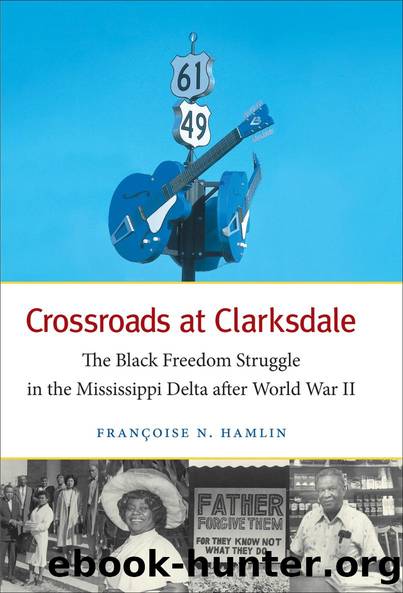Crossroads at Clarksdale by Françoise N. Hamlin

Author:Françoise N. Hamlin [Hamlin, Françoise N.]
Language: eng
Format: epub
Tags: Social Science, Ethnic Studies, African American Studies, History, United States, State & Local, South (AL; AR; FL; GA; KY; LA; MS; NC; SC; TN; VA; WV), Discrimination & Race Relations
ISBN: 9780807835494
Google: 1vVnWuaJCR4C
Publisher: Univ of North Carolina Press
Published: 2012-01-15T05:38:42+00:00
Children as Activists and Pawns
On 1 August 1972, a motion was filed to require the district to provide buses for elementary schoolchildren residing more than a mile away from school.67 In a subsequent hearing, Superintendent Robert Ellard reported the demographics in the seven elementary schools in the district (see table 4). The black, poor areas where Riverton, Washington, and Hall elementary schools were located show significantly more black students than white. Heidelberg and Kirkpatrick schools, located in predominantly white residential areas, reflect more equal racial numbers. Oakhurst, a white area on the cusp of black neighborhoods, saw a flood of black students in and an opposite wave of white students out. All the schools were predominantly black by 1972âthe majority of white students migrating to Lee Academy or to church-based schools.68
Ellard argued that trying to move students around to minimize busing would not change the racial composition of the schools. Leon Porter, chair of the Clarksdale Board of Trustees for at least four years, testified that âthe white pupil population has diminished sizably. . . . I think we lost over a thousand elementary white pupils. A thousand forty-three, if I recall correctly.â Arguing against busing, attorney Semmes Luckett for the school board said: âWhy should we have to bus a child to the equivalent of an all black school when he has got one right in his neighborhood that he can walk to the school? What necessity is there for us to do that?â All his pontificating proved fruitless. On 3 October, the district court ruled that the board had to work out how to create a transportation system, based on Swann, with the three existing buses in the city.69
Such tit-for-tat maneuvering between the black community (represented by the NAACP) and white citizens (represented by the school board) continued outside of the courtroom. For example, in the summer of 1972, the board received copies of a student conduct code, along with personal appearance regulations, discipline policy, and administrative procedures, for inclusion in the 1972â73 student handbook. The code came from the Pascagoula public schools, a district entangled in an extensive federal lawsuit due to many of the items included. The city board decided to forge ahead to implement these stricter changes.70 One of the codes governed student hairstylesâespecially the length of boysâ hair. In the days of the growing popularity of the Afro, which was encouraged by Black Power rhetoric, many black boys were punished for their stylish dos and sent home.
TABLE 4. Racial Demographics in the Seven Clarksdale Elementary Schools in 1972
Download
This site does not store any files on its server. We only index and link to content provided by other sites. Please contact the content providers to delete copyright contents if any and email us, we'll remove relevant links or contents immediately.
| General | Discrimination & Racism |
Nudge - Improving Decisions about Health, Wealth, and Happiness by Thaler Sunstein(7238)
iGen by Jean M. Twenge(5158)
The Fire Next Time by James Baldwin(5015)
Adulting by Kelly Williams Brown(4230)
The Hacking of the American Mind by Robert H. Lustig(4080)
The Sports Rules Book by Human Kinetics(4072)
The Ethical Slut by Janet W. Hardy(4036)
Captivate by Vanessa Van Edwards(3721)
Mummy Knew by Lisa James(3519)
In a Sunburned Country by Bill Bryson(3361)
The Worm at the Core by Sheldon Solomon(3325)
Ants Among Elephants by Sujatha Gidla(3278)
Suicide: A Study in Sociology by Emile Durkheim(2901)
The Slow Fix: Solve Problems, Work Smarter, and Live Better In a World Addicted to Speed by Carl Honore(2837)
The 48 laws of power by Robert Greene & Joost Elffers(2797)
Humans of New York by Brandon Stanton(2683)
Handbook of Forensic Sociology and Psychology by Stephen J. Morewitz & Mark L. Goldstein(2603)
The Happy Hooker by Xaviera Hollander(2581)
The Tipping Point by Malcolm Gladwell(2553)
